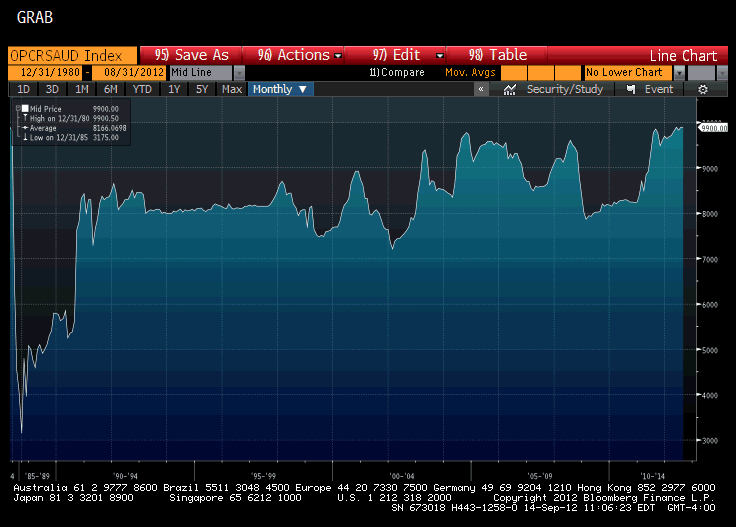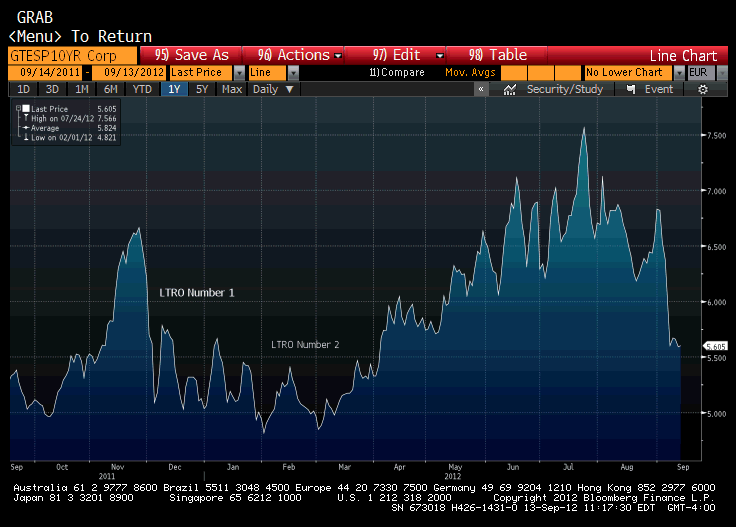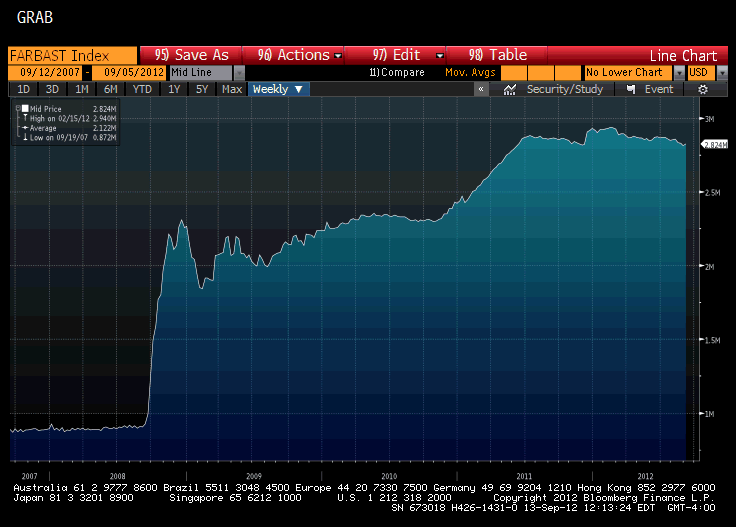Historically, the most terrible things – war, genocide, and slavery – have resulted not from disobedience, but from obedience.
– Howard Zinn
We cannot defend freedom abroad by deserting it at home.
– Edward R. Murrow
Talent hits a target no one else can hit; Genius hits a target no one else can see.
– Arthur Schopenhauer
2013: When Money Printing Meets Supply Constraints
I think 4Q12 and then 2013 will in many ways be the polar opposite of what we have seen thus far in 2012. As you all know, this year is a presidential election year in the U.S., which means predictably that the incumbent president does everything in his power (which these days is pretty much everything) to get reelected. As with everything else in life, there is no free lunch and there will inevitably be painful payback next year as the necessities of being returned to power fade momentarily. This is sort of obvious. What I find much more interesting is the actual global macroeconomic backdrop combined with what Central Planners have done as of late. Since late 2011 the Central Planners of the world began trying out a new strategy. Delay and jawbone, or propagandize and pray. In other words, when things started looking dicey all of these naked emperors (particularly in the EU) would call a meeting and threaten to take “drastic action” or some nonsense like that.
Let’s Talk EU
While the EU did engage in real action via the LTRO, this was basically just another shell game within a massive shell game of a financial system. The best way to really see what has happened in Europe is to take a look at the chart of Spanish 10 year government bond yields versus when the ECB has taken action.
As you can see above, yields spiked in late November and the response was the first LTRO program. This smacked yields down significantly, but things were still dicey and at the end of February they went for LTRO 2. As the chart demonstrates, the low in yields corresponded almost perfectly to LTRO 2 and from there on out they started soaring again, only to hit a new high of over 7.5%. Importantly, this was significantly higher than that the spike to around 6.6% in the fall of 2011, which had policy makers running around like chickens with their heads cut off.
Amusingly, the rhetoric from EU policymakers has become even more intense, frantic and aggressive in the last few months as clearly their prior grand plans have been complete and total failures. Statements are being made over and over like “the euro is irreversible” and other nonsense like that. First of all nothing in life is irreversible and I am quite certain Moctezuma was standing high above the earth yelling similar things from the grand Aztec pyramids right as Cortez was landing his ships. Such statements actually cement the euro’s ultimate demise in my mind.
So with the latest ECB call to action, Spanish yields have once again plunged a massive 200 basis points from over 7.5% to a little above 5.5%. If recent history is any guide, this move lower will be temporary and the market will once again force more desperate action and ultimately severe currency debasement.
What About the United States?
While the spotlight has been on EU issues and China’s economic collapse this year, I think most of the attention will be on the U.S. in 2013. Not only will there be payback for the election year nonsense that has held things together, but I think the market will finally force some real action. This means some very difficult decisions for The Bernank. As I mentioned above, although a lot of what the ECB and EU Central Planners have done over the past 18 months has been jawboning, they have taken some concrete steps to perpetuate the ponzi. The Fed on the other hand has been given a free ride for the most part, as they have been able to get asset prices to inflate without having to expand their balance sheet.
As you can see, the Fed’s balance sheet has basically flat-lined over the past year or so. They have mainly jawboned to keep thing together by threatening to do more should the economy deteriorate. Yes they have also done “Operation Twist,” but this is largely meaningless in the grand scheme of things. The game is all about publicly creating new money and buying securities with it and as of late we haven’t seen that. It is no coincidence that gold has experienced a major consolidation during the same time the Fed has kept its balance sheet steady.
The above paragraph was as far as I got at around noon yesterday ahead of the huge decision from the Fed to initiate QEI (or QE to Infinity). It’s interesting that just as I was writing about how the ball was about to be in their court, The Bernank pulled out the nuclear option. For my thoughts on the decision please read my post from yesterday titled The Gun Has Been Fired: Precious Metals to Hit New Highs. Also worth a read is my piece from earlier this year that predicted the inevitability of such a panic move by Bernanke in The Big Print is Coming.
The Big Print is Here
So here we are folks. The end of the line in monetary policy. The world changed yesterday, and while you can’t tell it from the VIX volatility index, I think volatility is about to soar. It may be kept under wraps until the election to some degree, but the closer we get to early November the wilder the swings in most asset prices will become. The fact that this happened yesterday fits in perfectly with the main theme of this piece. As we entered 2012, China still appeared to be growing solidly. As a result, the consensus was that investments in China economic growth sensitive commodities such as coal and iron ore would stay at elevated enough levels to keep mining investments on track and with attractive return profiles.
I have for a long time been negative on the “China story,” which is why my top recommendations for the past several years have been precious metals, agriculture and oil. These are in my view necessities. Money, food and energy. They will not see as elastic demand swings from economic weakness and will benefit significantly from currency debasement. They remain my top assets in which to be in to preserve wealth. In any event, the China ponzi appears to have now popped, and as a result, the prices for certain commodities like coal and iron ore have plunged. This is extremely important because it is already causing a major pull back in capital investment within the commodities arena. Take a read of this Reuters article from a few days ago: Australia miners slam brakes on huge pipeline of projects. The first paragraph says it all:
MELBOURNE, Sept 13 (Reuters) – A $246 billion pipeline of planned mining investments in Australia is on increasingly shaky ground, with nearly half already frozen or likely to be delayed, as miners and lenders wrestle with high costs and sliding revenue.
It’s not just coal and iron ore either. BHP just recently decided to cancel its Olympic Dam expansion, which is primarily a copper and uranium mine that was supposed to be one of the companies “mega-projects.”
The supply constraints are not just from project cancellations based on China’s slowdown. Let’s not forget the ongoing violence at platinum mines in South Africa. From today’s Wall Street Journal:
The move comes as more mining companies suspended operations amid continuing protests that have kept miners away from some of the country’s biggest platinum and gold operations, destabilizing the sector and threatening to curtail South Africa’s growth prospects.
I mean does anyone think these things are going to go away any time soon? Moreover, the Middle East is getting more unstable by the day and if anyone thinks an attack on Iran is off the table with these maniacs in charge of the Western world you’ve got to be in dream land. As I have shown many times before, the Saudis are already pumping at decade high rates and will be unable to come to the rescue. See the chart below.
Saudi Arabian Monthly Oil Production
The Set Up is Complete
The fact that the Fed has already instituted QEI means the setup is complete. Things may be kept together for another month and a half until the election, but the closer we get to that date the more concerned I would get. Money printing is about to have a head on collision with supply constraints, which is likely to lead to even more money printing. If I had to guess, I would say the single most likely thing to knock this Zimbabwe equity rally right on its back will be a monster oil price spike. With the Saudis already pumping where they are, the event wouldn’t even have to be a major one. I think it’s likely oil prices hit record levels by early next year and ultimately potentially move toward $175-$200/b before policy makers are forced to abandon their idiotic policies. As always, we shall see.
I’m off to Crested Butte for the weekend.
In peace and wisdom,
Mike
Donate bitcoins: 35DBUbbAQHTqbDaAc5mAaN6BqwA2AxuE7G
Follow me on Twitter.





The money printing is indeed massive but it is reserved only to the globalist fascist neocon working for the NWO. There is NO constraint for them. What these neocons print for themselves is simply just robbed to the rest. Greece is one fine example of the process. We are dealing in reality with eugenist nazis. The consequence of this massive money printing while starving the real economy will eventually result in WW III. It is already started. The FED that fascist organization financed Nazi Germany in the 30s to the tune of 30 billion dollars, a huge sum at the time.
Oh brother.
The FED will tighten rates first quarter 2013, there is NO QE infinity buzz lightyear. FED has followed Taylor Rule for 30 years and will continue to do so, dual mandate anyone? Act 2A!